RockyNH_RIP
Senior Member
I am not that clear of light pollution but I want to try anyway, just for the experience... I may work on a setup this weekend...
Thanks for the "motivation"!
Pat in GA
Thanks for the "motivation"!
Pat in GA
So you are telling me that all camera sensors record all the light that is available at ISO 100? And all we have to do is press 'Auto fix' in LR or the equivalent and we have an amazing photo ready to share to the FB world. But if we go to blow that photo up to even a wall sized print it would look crap?You don't need to believe me and if you prefer shooting at 6400 more power to you but in case you want to know what actually happens, this site is rather interesting.
www.Clarkvision.com: ISO and Digital Cameras, ISO Myths
I tested it and it seems to be correct, at least for those shots during those conditions. Before I always shot high ISO for stars but now I tried both, low does a better job for me.
I would suggest.@Scott Murray what setting suggestions and focal length suggestions do you have for milky way shots/low light? I haven't tried any and don't know where to start. My main lenses are listed in my signature. Thanks for any advice.


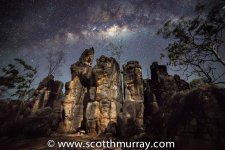
So you are telling me that all camera sensors record all the light that is available at ISO 100? And all we have to do is press 'Auto fix' in LR or the equivalent and we have an amazing photo ready to share to the FB world. But if we go to blow that photo up to even a wall sized print it would look crap?

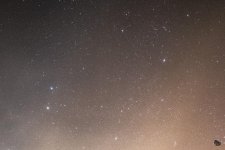
I would suggest.
D610, ISO 3200 (30% moon, no light polution)....
I hope that helps
I would normally decrease the ISO as I get too much light and it impacts on the final photo. Also you cannot capture the Milkyway during a full moon as there is too much light.Yes, the info helps. Thanks, Scott!One quick question...when there is light pollution, what changes in ISO/exposure do you make to compensate? Any?
Thanks Steve.Amazing shots, Scott!
Could I ask why you suggest the moon being at 30%?
I tried taking some last night with my new D600 and my old 17-55 (in crop mode) and it didn't come out very good, the moon wasn't out yet, but it was supposed to rise in an hour or so, and it rises around the area on the left
You can kind of see it going across the middle, this was at ISO 3200 2.8 and 10 sec, if I decreased the shutter speed it just made everything brighter, not just the stars.
View attachment 134107
But about a year ago, last March I took this photo below with my D7000, same lens,
But this was at ISO 400 2.8 and 60 seconds, BUT the moon had set about 3 hours earlier in the opposite direction
Was the rising moon in last nights photo maybe washing everything out? Bother were in the same spot, with the same amount of light from the city.
Maybe it was just hazy out?
View attachment 134108
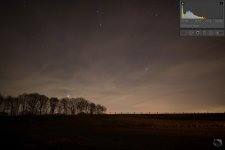

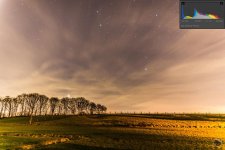
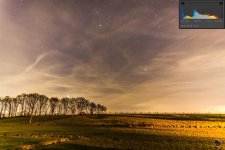
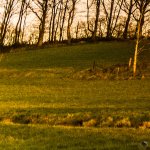
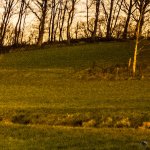
So, @J-see you figured out that keeping ISO low produces a better image? Or is there more to it?
I've been studying low light long exposure a bit of late so perusing the threads on such.
Can't say that I've managed to follow all the thoughts in the last few pages though. Some of it sounds like shutter and f/stop have no effect, but I'm guessing I'm just missing something.
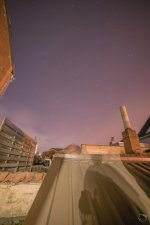

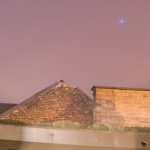
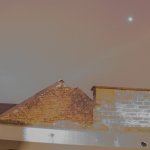
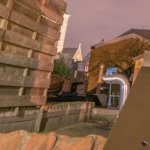

It's actually the opposite; shutter and f/stop are the important parts for exposure.
I've always been shooting high ISO for stars, as I read somewhere, tried and since it worked, kept doing. (<-- the downside of tutorials) But because it works it is not necessarily the better or best method. Eureaka! My other night shots I used ISO 100 since they were mainly landscapes and for those shutter is not limited like stars. But during those I often noticed my sky and stars to be pretty ok even at this low ISO. I didn't understand why that was the case since high ISO increased my sensitivity and this should make a massive difference there. Stars are suns and they are very bright, so a low ISO makes perfect sense. I've found stars in nightscapes that I didn't know were there until I was processing.
To know what went on I had to inform myself about the very fundamentals first: how does this cam work? Not the settings but the hardware; what goes on when I expose? While reading more and more about it I stumbled upon that site linked in a previous reply and read that ISO does not increase the sensitivity of the sensor since our sensors don't have multiple sensitivity settings. That's a myth but about everywhere being sold as truth. Our sensors pixels have a certain efficiency and that's all. You can read everything about it in that link. I glanced at the page. Can't say how accurate all the info is, but my understanding is a sensor is just that. It senses what is allowed to get to it. Changes in ISO are changes in how the recorded signal is amplified.
This implies that you could say there are two kinds of exposures; the exposure of the shot we take and the exposure of the cam, which is the actual exposure of the sensor to light. (This is where we need to be careful. Better to come up with a new word or phrase to describe what you're thinking. I almost (maybe did) got lost here.) The only thing that affects the sensor's exposure is the aperture and shutter duration. (OK, makes perfect sense) ISO and everything else affects the [SUB]exposure[/SUB] processing** of your shot which is post sensor. Using good old ISO 400 film, the shutter and f/stop were the only tools of exposure. The film was the film, just like the sensor is the sensor. We could boost the film in processing to get more speed and to do this we shot at the speed we were planning to boost to. Sensors seem to work the same except the boosting or amplifying is done in camera and not in a lab. **less confusing word
During the daytime this isn't very important but for night shots it is very relevant. The more light the better the signal, the less noise but as many of us assume, ISO does not add more light; it multiplies the light already present since it only changes the read-out of the sensor pixels. But while doing, it multiplies the noise too. The only light that makes the difference is the light that hits the sensor and here only shutter and aperture can improve. Need to read what I highlighted in red as it does not mean what you intended it to mean. I think I'm still following the thought though.
Upping the ISO also lowers the brightness levels and in that affects the DR. You gain in the shadows but each ISO stop that gain is less. If we up the ISO we tell the cam that now it should read sensor pixels that are less saturated as if they are more saturated and in that we lose more and more levels that are pushed into 255, fully saturated which shows as white clipping in our shots.
Buckets of water are often used to explain this. If you imagine each sensor pixel to be a bucket filled with water, when we change ISO, we use a smaller bucket instead. We don't measure the water but the amount this water fills the bucket. What was "half a bucket" first, now is "a full bucket". What was "a quarter of a bucket" becomes "half a bucket". What used to be "a full bucket" before now actually becomes "twice the bucket" but since "a full bucket" is our maximum for these measurements, "twice the bucket" is considered as equaling "a full bucket". In all of this there is one constant; the volume of water. Regardless how I measure the water present, that measurement does not change its volume. This is when folks start thinking your bucket is only half full. <<<<Whoa, I just had to toss that in for a little mid post humor, since you walked right into it with all those buckets.
Seriously though, too many buckets.
We gain at the other end since the multiplication now creates a difference where first was too little. But for these kind of shots the shadows matter less. It's all about the light.
So in the end when you use a fixed shutter and aperture, the only difference that ISO makes is an increase in noise while lowering the DR the cam can grab. If it is possible to shoot at ISO 100, do it, even at night. ISO 100 will not magically make night shots picture perfect nor will it be noise free. Compared to high ISO it is only noise less. All digital signals have noise. This is true, but like so many things photographic, it's the acceptable noise we are after and low ISO will always have less noise than higher ISO. When higher ISO setting amplifies the signal, it amplifies everything.
The trick is to maximize the sensor's exposure by increasing the shutter duration as long as possible while opening the lens as wide as possible. The more light hits the sensor, the better the SNR. Eureka! Once you hit the limits there, do the rest in post. I think there is a balance in what we let the camera process and what we do in post and trade-offs.
This evidently is not the case when there is massive clipping to begin with. Why the cam does not store the read-out of those clipped levels I don't know yet but it doesn't and there's next to nothing I can do about that. Or maybe it does but I need to get that read-out somehow. Evidently when pixels have no signal read out or are fully saturated at the native ISO, there's nothing more to get. It'll require some more digging to find the information I lack and understand that part.
Here are two identical shots when it comes to sensor exposure. They only differ in shot exposure because of ISO. 100 ISO should always produce a better shot for an equivalent exposure. I'm not sure it really proves anything when we purposely amplify a signal that did not need amplifying. But, experimentation can be illuminating
In post I increased the exposure by 3 stops for the 100 while lowering by 3 for the 6400. After that, they're exposed equally in terms of shot exposure and sensor exposure. Then I killed the shadows (+100) and highlights (-100) and set the black and white at the lowest opposite. (+100 black, -100 white).
Of course I can process them in such a manner the differences will be less noticeable but never until they're identical.
